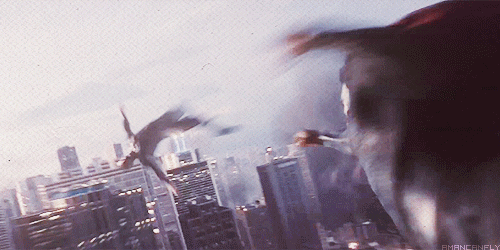It also doesn't help that-- unlike on Flash and Arrow-- the majority of the big action sequences in Supergirl are taking place in bright daylight instead of at night. Which probably makes them even harder to achieve and make look believable.
I still think they look pretty amazing by TV standards. As I said, because of the kind of FX I grew up with, I don't dwell so much on how perfect they are and focus more on what they're showing me, what actions and events they're depicting. I'm just thrilled that we're actually getting to see a lot of Supergirl actually saving people and doing superfeats, instead of just having her spend 40 minutes of the episode as Kara and 2 minutes as Supergirl and maybe hold up the back of one car and smash through one wall.
What I always loved about the slower and more balletic movements in the Donner movies was that it conveyed the sense of people flying through real air, who might continue drifting a bit as they changed direction or who had to sometimes "push off" again to regain momentum, or angle their bodies the right way to fight the air currents.
You got the sense that Donner really thought all that stuff through, and it really makes up for any lack of photorealism those effects might have now, at least in my book.
Well, of course, the actors moved that way because they actually were physically suspended in midair and being moved around. And they couldn't be moved too quickly without overstressing the wires.
My father, who was of the generation that would've been the original target audience for Superman on comics and radio in the late '30s and '40s, and who maybe watched the George Reeves show as a young adult, once told me that he didn't like the way Christopher Reeve's Superman just slowly levitated into the air. He could understand that it was necessary because of the functional and safety limitations of the wires, but he was used to thinking of Superman's liftoffs as something much more forceful. On radio, it was often described as like a rocket taking off or an arrow being fired, and George Reeves had his springboard liftoffs. In the Fleischer cartoons, Superman's liftoffs were almost explosively abrupt and powerful. So having him just gently waft into the air like Peter Pan on stage was kind of revisionist to someone like my father, who'd grown up with a different image of how Superman took flight.
I dunno, it's hard to really say how Superman would fly in any real life and what he'd look-like "pushing-off" the air. I mean, he's able to move, change direction and propel himself without any obvious means of interacting with environment.
Still, one would expect he'd need to apply some kind of force to cancel or redirect his considerable momentum, and that it therefore wouldn't be instantaneous when he changed course. Although there is a theory that he has the power to cancel inertia, which is how he can catch people falling from great heights without hurting them or carry gigantic objects around without them collapsing under their own weight. Though Supergirl's mishap with the oil tanker a while back suggests she doesn't have that ability, or at least doesn't have it mastered yet.
For the time the effects in the Donner movie and sequels look good but it still looks like a man hanging on wires. Just the way he moves has that look. He seems to "dangle."
I've never thought that about Reeve. His experience as a glider pilot enabled him to give a very convincing appearance of managing his flight by shifting his weight and attitude. But Zod, Non, and Ursa in
Superman II absolutely did look like they were just dangling on wires. I'm puzzled that nobody suggested that Reeve give them movement coaching. (Helen Slater did a pretty good job too, though she used more of a balletic/swimming attitude, with arms out to her sides and one knee bent. Benoist often does the knee-bend thing too.)
Even Smallville could only do so much with any "super powered" scene.
Although they got better over time. I think that in their last two seasons, they really raised their game and did some highly impressive action shots. Although it tended to be one or two "wow" moments per episode, rather than whole long sequences.
Hell, look at "Lois and Clark" which was restricted to wire-work and blue-screen, and it holds it back.
I've been rewatching L&C on DVD lately, and they did actually use CGI to an extent. It was the '90s, after all, not the '80s. There are some bits in the special features showing how they used a CGI Clark or Superman in some of the flying shots -- for instance, there's a bit in the pilot where Clark takes off from an alley and flies home to Smallville, and as the camera follows him up from the alley, it transitions from the stuntman on wires to the CGI version of Clark against a CGI sky. There's also that shot used in the titles every week, where Superman flies Lois in through the
Daily Planet office window for the first time, and the top of the window frame is CGI, because of course the actors were hanging from wires.
Still, the show's budgetary limitations means it often had some very limited Superman action. I've gotten tired of how many times Superman "flew off" just by having Dean Cain flourish his cape in front of the camera and run offscreen while the other actors lift their eyes skyward.




